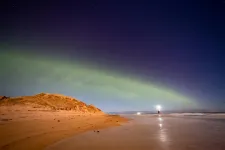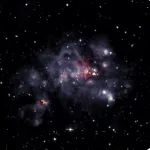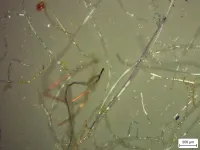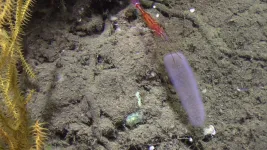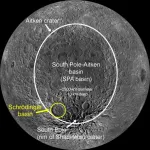(Press-News.org) A new auroral phenomenon discovered by Finnish researchers a year ago is probably caused by areas of increased oxygen atom density occurring in an atmospheric wave channel. The speculative explanation offered by the researchers gained support from a new study.
Observations made by University of Helsinki researchers increased the validity of a speculative mechanism according to which a type of aurora borealis named 'dunes' is born. In the new study, photographs of the phenomenon taken by an international group of hobbyists in Finland, Norway and Scotland were compared to concurrent satellite data.
The rare type of aurora borealis was seen in the sky on 20 January 2016 and recorded in photos taken by several hobbyists.
"The dunes were seen for almost four hours in a very extensive area, with the pattern extending roughly 1,500 kilometres from east to west and some 400 kilometres from north to south," says Postdoctoral Researcher Maxime Grandin from the Centre of Excellence in Research of Sustainable Space coordinated by the University of Helsinki.
Useful photographic and video material was collected in close cooperation with Finnish aurora borealis hobbyists, utilising both the internet and social media. Among other things, a time lapse video shot on the night in question by a Scottish hobbyist was found. The video was used to estimate the dunes' propagation speed at over 200 m/s.
The study was published in the esteemed AGU Advances journal.
Validity of the wave guide theory confirmed
Northern Lights are born when charged particles ejected by the Sun, such as electrons, collide with oxygen atoms and nitrogen molecules in Earth's atmosphere. The collision momentarily excites the atmospheric species, and this excitation is released in the form of light.
New types of aurora borealis are rarely discovered. The identification of this new auroral form last year was the result of an exceptional collaboration between hobbyists who provided observations and researchers who started looking into the matter.
The new auroral form named dunes is relatively rare, and its presumed origin is peculiar.
"The differences in brightness within the dune waves appear to be caused by the increased density of atmospheric oxygen atoms," says Professor Minna Palmroth.
A year ago, researchers at the Centre of Excellence in Research of Sustainable Space concluded that the dune-like shape of the new auroral emission type could be caused by concentrations of atmospheric oxygen. This increased density of oxygen atoms is assumed to be brought about by an atmospheric wave known as a mesospheric bore travelling horizontally within a wave guide established in the upper atmosphere.
This rare wave guide is created in between the boundary of the atmospheric layer known as the mesosphere, which is called the mesopause, and an inversion layer that is intermittently formed below the mesopause. This enables waves of a certain wavelength to travel long distances through the channel without subsiding.
The electron precipitation and temperature observations made in the recently published study supported the interpretations of the dunes' origins made a year earlier. An independent observation was made of the wave channel appearing in the area of the dunes, but there are no observation data for the mesospheric bore itself yet.
"Next, we will be looking for observations of the mesospheric bore in the wave guide," Maxime Grandin says.
According to the observation data, electron precipitation occurred in the area where the dunes appeared on 20 January 2016. Therefore, it is highly likely that electrons having the appropriate energy to bring about auroral emissions at an altitude of roughly 100 kilometres were involved. The observations were collected by the SSUSI instrument carried by a DMSP satellite, which measures, among other things, electron precipitation.
On the night in question, there was an exceptionally strong temperature inversion layer in the mesosphere, or a barrier generated by layers of air with different temperatures. The inversion layer associated with the origins of the wave channel was measured with the SABER instrument carried by the TIMED satellite. The observation supports the hypothesis according to which the auroral form originates in areas of increased oxygen density occurring in the upper atmosphere wave guide.
INFORMATION:
The photographic and video material was acquired from aurora borealis hobbyists in three countries: Graeme Whipps (Scotland), Mark Ferrier (Scotland), Jukka Hilska (Finland), Kjetil Vinorum (Norway), Knut Holmseth (Norway) and Barry Whenman (Scotland).
Article:
Grandin, M., Palmroth, M., Whipps, G., Kalliokoski, M., Ferrier, M., Paxton, L. J., Mlynczak, M. G., Hilska, J., Holmseth, K., Vinorum, K., and Whenman, B. (2021). Large-scale dune aurora event investigation combining Citizen Scientists' photographs and spacecraft observations. AGU Advances, 2, e2020AV000338, https://doi.org/10.1029/2020AV000338
Time lapse video: https://youtu.be/F6xM-XY6NYg
Further information:
Maxime Grandin, postdoctoral researcher, +358 50 316 9905, maxime.grandin@helsinki.fi, @Maxime_Grandin, University of Helsinki
Minna Palmroth, professor, +358 50 311 1950, minna.palmroth@helsinki.fi, @MinnaPalmroth, University of Helsinki and Finnish Meteorological Institute
This overlay shows radio (orange) and infrared images of a giant molecular cloud called W49A, where new stars are being formed. A team of astronomers led by Chris DePree of Agnes Scott College used the National Science Foundation's Karl G. Jansky Very Large Array (VLA) to make new, high-resolution radio images of this cluster of still-forming, massive stars. W49A, 36,000 light-years from Earth, has been studied for many decades, and the new radio images revealed some tantalizing changes that have occurred since an earlier set of VLA observations in 1994 and 1995.
The ...
Scientists have developed a new "key-hole surgery" technique to extract metals from the earth - which could revolutionise the future of metal mining
A team of international researchers, including Dr Rich Crane from the Camborne School of Mines, University of Exeter, have developed a new method to extract metals, such as copper, from their parent ore body.
The research team have provided a proof of concept for the application of an electric field to control the movement of an acid within a low permeability copper-bearing ore deposit to selectively dissolve and recover the metal in situ.
This is in contrast to the conventional approach for the mining of such deposits ...
Swansea University scientists have uncovered potentially dangerous chemical pollutants that are released from disposable face masks when submerged in water.
The research reveals high levels of pollutants, including lead, antimony, and copper, within the silicon-based and plastic fibres of common disposable face masks.
The work is supported by the Institute for Innovative Materials, Processing and Numerical Technologies (IMPACT) and the SPECIFIC Innovation & Knowledge Centre
Project lead Dr Sarper Sarp of Swansea University College of Engineering said:
"All of us need to keep wearing masks as they are essential in ending the pandemic. But we also urgently need more research and regulation on mask production, so we can reduce any risks to the environment and ...
Pyrosomes, named after the Greek words for 'fire bodies' due their bright bioluminescence, are pelagic tunicates that spend their entire lives swimming in the open ocean. They are made up of many smaller animals, known as zooids, that sit together in a tubular matrix, known as tunic (hence the name pelagic tunicates). Because they live in the open ocean, they generally go unnoticed. In spite of this, increasing research points to their importance in marine environments, as they can form dense blooms that impact food web dynamics and contribute to the movement and transformation of organic carbon.
The study conducted with GEOMAR research vessel POSEIDON in 2018 and 2019 in the vicinity of the Cabo Verde Islands, of which the results have now been published ...
Scientists at the Walter Reed Army Institute for Research demonstrated that biomarkers associated with traumatic brain injury were elevated among law enforcement and military personnel, particularly in active duty participants with longer duration of service. Most notably, these elevated biomarker levels were observed in individuals without a diagnosed brain injury or concussion.
Some law enforcement and military personnel are regularly exposed to low levels of blast, particularly during training, due to the use of explosive charges and high caliber weapons. Understanding effects from these occupational exposures is a military health care priority to improve ...
FAYETTEVILLE, Ark. - A new map including rover paths of the Schrodinger basin, a geologically important area of the moon, could guide future exploration missions.The map was created by a team of interns at the Lunar and Planetary Institute, including Ellen Czaplinski, a University of Arkansas graduate student researcher at the Arkansas Center for Planetary Sciences and first author of a paper published in The Planetary Science Journal.
The researchers identified significant geologic features of the Schrödinger basin, located near the lunar south ...
Researchers at the U.S. Department of Energy's National Renewable Energy Laboratory (NREL) developed a breakthrough in energy-efficient phototransistors. Such devices could eventually help computers process visual information more like the human brain and be used as sensors in things like self-driving vehicles.
The structures rely on a new type of semiconductor--metal-halide perovskites--which have proven to be highly efficient at converting sunlight into electrical energy and shown tremendous promise in a range of other technologies.
"In general, these perovskite semiconductors are a really unique ...
Hypertension is a common medical condition and a primary cause of cardiovascular diseases and stroke worldwide. Unfortunately, as Professor Wei-Li Zhang of the Chinese National Center for Cardiovascular Diseases notes, "the unaffordability of drugs is a major barrier to medication adherence among patients living in low- and middle-income areas."
One of the countries where hypertension is becoming a major problem is China where, researchers estimate, between 244 million and 300 million adults are living with hypertension. But true to Prof. Zhang's words, most cases of hypertension in China are not adequately ...
With the explosion in digital entertainment options over the past several decades and the more recent restrictions on outdoor and in-person social activities, parents may worry that excessive engagement with digital technology could have long-term effects on their children's mental health.
A new study published in the journal Clinical Psychological Science, however, found little evidence for an increased association between adolescents' technology engagement and mental health problems over the past 30 years. The data did not consistently support the suggestion that the technologies we worry about most (e.g., smartphones) are becoming more ...
DURHAM, N.C. - When patients complain of coughing, runny nose, sneezing and fever, doctors are often stumped because they have no fundamental tool to identify the source of the respiratory symptoms and guide appropriate treatments.
That tool might finally be on its way. In a study proving feasibility, researchers at Duke Health showed that their testing technology can accurately distinguish between a viral and a bacterial infection for respiratory illness - a critical difference that determines whether antibiotics are warranted. And, importantly, the test provided results in under an hour.
"This is exciting progress," said study lead Ephraim Tsalik, associate professor in the departments of Medicine ...
